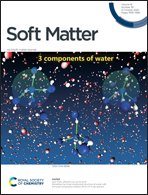Self-assembly in systems based on l-cysteine–silver-nitrate aqueous solution: multiscale computer simulation†
Abstract
We use fully atomistic, quantum mechanics and mesoscopic simulations to investigate multiscale structure formation in a supramolecular system based on aqueous solutions of silver nitrate with L-cysteine (CSS). Fully atomistic modeling reveals that silver mercaptide clusters are formed in solution at the stage of aging, which has a pronounced “core–shell” structure. The core is formed due to the bonding of SAg groups of silver mercaptide (SM) zwitterions while the shell consists of NH3+ and C(O)O− groups. Self-assembly of large-scale aggregates in CSS occurs due to the interaction of SM functional groups located on the surface of the clusters, which allows them to be considered supramonomers. Quantum-mechanical calculations reveal additional insight into the intermolecular interaction of L-cysteine with the components of the system. The data on the structure and properties of supramonomers are used to develop and parameterize a mesoscopic CSS model supplemented with allowance for salt concentration. In the mesoscopic model, supramonomers are presented as “sticky spheres”, the interaction between which is determined by short-range and screened Coulomb potentials. Depending on the salt concentration, all structural transitions typical of CSS are observed: the formation of a stabilized colloidal dispersion, the filamentary aggregates of a gel network, the formation of large-scale unbound aggregates, and precipitation. These stages qualitatively reproduce the experimentally observed behavior of a real solution.



 Please wait while we load your content...
Please wait while we load your content...